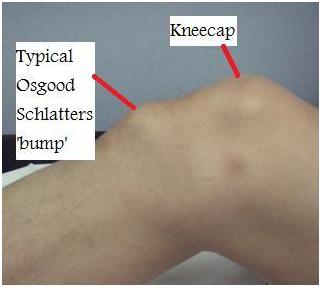by Mark Roe
We have all had team mates who complain about knee pain, and if you have ever had it yourself, you’ll know it can be quite disabling at times, especially when you are in adolescence. Often, parents take their children to the doctor only to be told “it’s growing pains – rest from sport for 6 weeks”. This was the worst thing any doctor could have said to me at 14 years old! However I did as I was told, and eventually (much more than 6 weeks later) the knee pain settled.
As our bodies grow, particularly through puberty, we go through something called a growth spurt. This is where many children develop knee pain in the form of ‘Osgood Schlatter’s Disease’ (OSD) or heel pain which is called ‘Severs Disease’(SD). It is thought that as we grow, our bones enlarge faster than our muscles. This makes it feel like the muscles are really tight, and they become painful on parts where the tendon of the muscle attaches to the bone.
Although this can happen at several areas of the body, the most common seem to be directly on the front of the shin just below the kneecap (OSD) and at the weight-bearing point of the heel (SD).
Today we are going to look specifically at OSD.
Who gets Osgood-Schlatter’s disease?
OSD is common in young teenagers, between the ages of 12-15 and seems more prevelant in boys. It is uncommon over the age of 16. Teenagers who play a lot of sport involving kicking, running, or jumping or activities which involve repeated and vigorous use of the quadriceps muscles, more commonly suffer. However, it can also occur in children who are not sporty.
The main symptom is pain just below the kneecap. The pain can be variable and more people report it as a problem during, and just after, activity. However, it does tend to ease with rest.
The pain typically lasts a few months, but for some youngsters it can last much longer until the ‘growth spurt’ has finished. This means that in some cases it can last up to two years.
As well as activity related pain, we need to look out for a small, tender, bony bump may develop where the pain centre is below the kneecap. This bump can enlarge with increased activity, and although the bump becomes permanent, the pain here will eventually settle down. The actual knee joint is not affected, so fortunately, knee movements are normal, although it does cause people to walk with a limp. In a third of cases, teenagers will have the problem at both knees.
What causes Osgood-Schlatter’s disease?
It is thought that overuse of the thigh muscles (quadriceps) during the growth spurt is the most common cause. The tendon which attaches the thigh to the top of the shin, (via the kneecap) becomes inflamed and causes pain at the site of the attachment. In some cases, a small flake of bone is pulled off the top of the shin bone. Healing bone called a callus then forms over this area causing a hard bony bump to develop.
What is the treatment of Osgood-Schlatter’s disease?
The pain usually goes within a few months without any treatment, but looking after your muscles and being sensible can speed the process up. It needs to be said that the condition is not serious and will eventually settle on it’s own.
Many years ago, doctors used to advise complete rest, however more recently it has been found that complete rest is not always necessary. It is now thought that best management is to follow a stretching programme for the lower limb muscles, take appropriate pain relief or anti-inflammatories as approved by your pharmacist, regular icing and ‘relative rest’ from sport or aggravating activities. The stretching needs to be done everyday – not just when playing- and should target the main muscles of the leg. Ie. calfs, hamstrings, quads and buttocks.
How much sport can I play?
Although sport or physical activity is not likely to cause any permanent damage, it will usually make the pain worse. With this in mind difficult decisions may have to be made about training schedules and sporting commitments. I would always advise to reduce the amount you play in every case. Even if you only play 15 minutes at each training session and match, the body is active, you are still keeping some match-fitness and the manager doesn’t forget about you! This is better than being scared of missing out and playing through the pain as this will only hinder your performance and you then risk being dropped altogether. Also think about how much you play in the school yard, or with friends in the evening. If you do this less, it may mean you will be able to manage longer at the weekend matches.
The time during a growth spurt can be very frustrating for a player as often they may be one of the best players in the team, but over a brief period suddenly look poor, or slow. This is where managers and parents need to look after the player and reassure them that this is temporary, and their form will return when the symptoms settle.
If this is happening to you, make sure you tell your manager and parents, and follow the guidelines above. It is wise to have an initial consultation with a registered physiotherapist to confirm the diagnosis. Follow up sessions of physiotherapy should not really be necessary if you follow the management ideas above.
Stay focussed, remember this problem will resolve, and work hard at your stretches to speed up your time on the sidelines!
Good Luck! Mark

